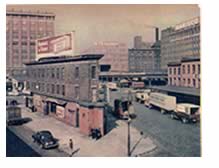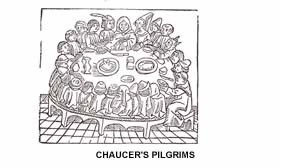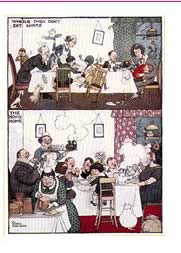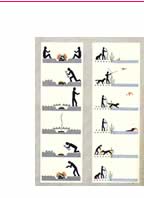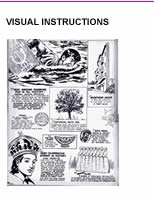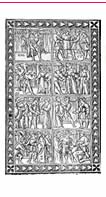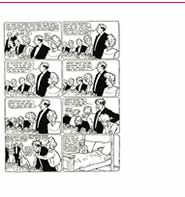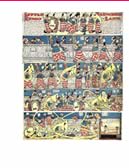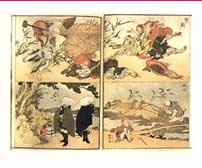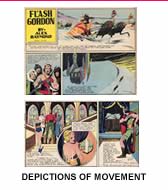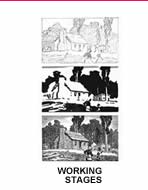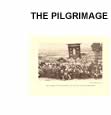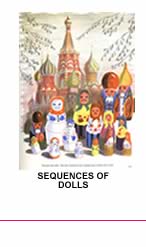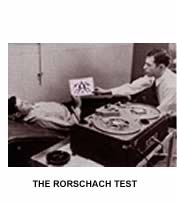NOTES TO THE ABOVE..........
PHOTOGRAPHY
IN DETAIL This is a Jerry Cooke photograph for an article on
Nabisco (National Biscuit Company) Fortune magazine June 1948
Walker Evans
writes,
"The picture is quiet and true. Since I am writing about photography
let me point out that this picture is a better part of the story at hand
than either a drawing or a painting would be. There is a profitable and
well-run cracker firm in a sweaty part of the town, there is a knot of
men talking on the pavement about anything but crackers, amidst the irrelevant
trucks. This is where Mal-o-Mars are cooked and this is where last week's
newspaper meets the gutter too. And the Strand Hotel becomes famous for
flavour. My point is Fortune photographs should take a long look at a
subject, get into it, and without shouting, tell a lot about it."
to R.D. Paine, 23.7.48 (Walker Evans at Work). |
| GETTING
IT WRONG American cartoon 1953 |
| CHAUCER'S
PILGRIMS from William Caxton's edition of The Canterbury Tales
, c.1484 |
| THE
A AND B COMPARISON
01
from Baden Powell's Rovering to Success , undated, 1929.
And very much the profile in BPs mind of British Youth in the first decade
of the 20th century. As a comparison it seems rather unfairly weighted.
The smoker appears to be at least 50 years of age. It is the author's
own drawing.
02 Straight
Comparison; the Hovis Home and the Non Hovis Home by Heath Robinson. Advertisement
UK 1910 . |
IMAGES
OF AGEING
01 HOW A
CHILD GROWS UP, Marion Chadwick photographed by her mother with her father
from 1922 to 1936, an image used to promote Dextrose sugar for your body's
growth. Corn Products Refining Co., from a campaign from June 1943. Less
obvious is the deterioration of the parent behind - going from a healthy
athlete to a mere wraith of a man, an ectoplasmic emanation.
02 Bruce
Bairnsfather (1888 - 1959) was one of a gathering breed of talented amateurs
who first learned art on a correspondence course (John Hassall's School).
After working for the advertising agencies, he joined the Army at the
beginning of the Great War. He sent a sketch to The Bystander magazine
and found he was suddenly greatly celebrated. The long suffering sauciness
of the old Tommy caught the national mood although questions were asked
in Parliament as to the mocking of our Great heroes. Old Bill's catchphrase
caught on as well, "If you knows of a better hole, go to it !"
The Evolution of Old Bill, from Percy Bradshaw, They Make Us Smile, Chapman
& Hall London 1942 |
VISUAL
INSTRUCTIIONS
01 Ripley's
Believe It or Not, an example of instructional material
in comic strip format, through which many people actually got their education.
02. two sequences
of simple strips by the Isotype Institute from a visual history of man,
and reproduced in Lancelot Hogben, From Cave painting to Comic
Strip, Max Parrish & Co., London 1949, a book with 20 pages
in colour and 211 illustrations in black and white, selected by Marie
Neurath, Director of the Isotype Institute. "Discipline of Design,
and a pattern of elements so familiar as to compel immediate recognition,
made possible visual aids which can raise th educational level of the
community."
What is the problem these images are trying to solve ?
Comment on the means chosen to represent the sequences.
What sort of sequences are they ?
Hogben's book is a useful and stimulating account of visual communication.
|
COMIC
STRIPS
01.above
Krazy Kat
01. below
Rube Goldberg traces the changes in Fashions.To the element of the metamorphois
he adds a convincingly cinematic sequence of the one figure walking, while
the changes happen in regular form.
Style of Men's Hats and Pants, 1912. Rube Goldberg (1883 - 1970) was one
of the great pioneers of narrative illustration; he was the master of
the extended series based on simple idea
eg. I'm the Guy (1911 - 1934)
The Inventions of Professor Lucifer Gorgonzola Butts
(1914 - 1964).
and Foolish Questions (1909 - 1934)
see Peter Marzio, Rube Goldberg, His Life and Work ,
Harper & Row NY 1973
02. Eight
Panel presentation of a narrative. Terentius, works,
printed in Tusculanum on the shores of Lake Como by Paganini's Press in
1526. The actual story is unclear from the images and its interpretation
awaits my readings in Terentius. There is an interesting typographic device
to identify each character.
03. Gasoline
Alley, American Comic Strip
04. Krazy
Kat, American comic Strip
05. Lyonel
Feininger, five drawings for Wee Willie Winkie , dated
1907 and measuring 30 x 40 cms. Feininger brilliantly evokes the gathering
and venting of storm clouds with a panel structure much influenced by
the Vienna Secession graphic culture.
06 . This
was used at Cartoon Theme Day as an example of brilliant transitions over
a nightmarish period of time, and complete control over the passage of
time. Winsor McCay (1869 - 1934) worked as a stage performer and newspaper
cartoonist. In 1907 he decided to become an animator and two years later
produced the film Little Nemo. In 1917 he produced his
greatest achievement The Sinking of the Lusitania . His work shows the
highest standards of drawing. Some images show early use of Rotascoping,
or at least tracing from photographs, but film of him drawing show astonishing
facility and formal invention. In any study of the Sequential, he must
be seen as one of the Great Pioneers.
07 row beneath
left, more Winsor McKay Little Nemo in Slumberland . |
DIFFERENT
NUMBERS OF PANELS Compare the formal dynamics of the three following
examples; two three panel images and a double page spread containing four
images.
01. Katsukawa Shunsho (1726 - 1792) three actors dancing the Sparrow
Dance , a Hosaban triptych 1765, each panel 32 x 15cms. The figures
from a play are shown dancing across a plank bridge with lily pond beneath.
02. Kuniyoshi,
Ushiwaka and Benkei fighting on the Gojo Bridge, c1840,
03. Hokusai,
Figures in the Rain, a double page spread from Shuga
Ihiran, 1818. |
| STYLISTIC
SEQUENCE CHANGES Punch, April 10th 1929 p.403, 18 x 24,
drawing by Lewis Baumer. |
DEPICTIONS
OF MOVEMENT Impressions of Movement within the Comic Strip. . Alex Raymond's
FLASH GORDON strip, as printed on the back of Modern Wonder
June 24th 1939. Compositionally a sophisticated flow across the page using
circular vignettes and flow of mountain and stair bannister to help the
eye around the page. The balance of immediate and background colours really
helps with th impression of movement.
All Alex Gordon's work is marked by the highest standards of drawing. |
| IMPOSSIBLE
NARRATIVES This site is dedicated to the rules of plausible narratives.
This section starts with a visual narrative that is wholly implausible,
delightfully so, and part of a magnificent campaign by The Continental Insurance
Companies. This is only a small part of the pessimist's vision of the world..
This represents, in one compressed image, the following hazards - Goods
in Transit - Automobile Damage and Liability - Other Liability - Burglary
- Robbery - Employee Fidelity - Destruction or Forgery of Securities and
Documents... December 1963, 24 x 26cms. |
WORKING
STAGES
Three Stages in a Scraperboard drawing, from Gene Byrnes, A Complete
Guide to Drawing , Simon & Schuster, New York 1948; p.311,
Franklin Booth's preparations for an image for the New York Telephone
Company,
|
| WORKING
DRAWINGS
A. The first
pencil indications in preliminary sketch.
B. Preliminary
sketch completed in pencil.
C. Pen and
ink outlines after preliminary sketch has been traced onto illustration
board (Pencil lines then removed)
D. Cartoon
developed with ink washes.
from Richard Taylor, Introduction to Cartooning, Watson
Guptill, NY 1947; and the distilled visual wisdom of the celebrated New
Yorker cartoonist.
See also Lecture on The New Yorker.
|
THE OLD KREMLIN
LINE-UP RETURN The Sequence of Figures in a Kremlin Lineup. .One of the
sequences that, if altered, made a difference to all of us was the lineup
of Soviet politicians at the Kremlin in the October march past of joyful
comrades and enormous rockets. The Kremlin watcher could tell who was on
the rise and whose fortunes slumped just on the evidence of the sequence
of the furcapped members of the Sinking Gerontology jostling for places
on the walkway.
|
THE
PILGRIMAGE
Going on
a Pilgrimage : the prescribed route
A pilgrim is one who journeys to some sacred place as an act of devotion,
and normally by a determined route. There are specified places for worship,
usually in the presence of some relic. See Marie Madeleine Gauthier, Highways
of the Faith , Alpine Fine Arts, London 1987. There are many published
accounts of the rituals enacted and the privations endured on a pilgrimage.
Here is a favourite - a pilgrimage in Brittany in 1911. The religious
ceremonies of the Breton people were of abiding interest to scholars and
artists. Gauguin and Wyndham Lewis looked on with a sense of awe. In Lewis'
case his interest was tempered by a fascination with their quaint and
intuitive ways which he mocked/analysed in a set of short stories as early
as 1909.
"Just as England has her Cornwall, so has Brittany her Cornouille,
viz. Amorican Cornwall.... " Every sixth year a 'pardon' was held
in honour of the sixth century saint S.Ronan. The Grande Tromenie is held
on the second Sunday of July, and is a mass procession that follows the
route taken by two oxen who, on the saint's death, were allowed to wander
of their own accord from his place of death to a place of burial ( the
hill outside the village of Locranon). After a service in the church nearly
15,000 worshippers climb the hill with their relics, past crosses and
other memorials. The author complained that he could only find refreshment
at the summit in drinking syrups, each stickier than the last. How different,
he complains, from the Godless hordes of England's Epsom and Derby Day." |
RUSSIAN
DOLLS
Matryushka
from Gwen White's The World of Dolls, published in 1962
and drawn throughout on the lithographic stone and printed by
Cowell's of Ipswich.
Although
not exactly the nested personages of the conventional Russian Dolls, these
do remind us of the narrative possibilities of narratives that lie inside
other narratives. |
| JOINING
THE DOTS One of the most fundamental of all sequences - disastrous
if disobeyed. |
| SEQUENTIAL
TITLE PAGES - that title pages for books construct a layered sequence
that informs the reader something of the content. Here the titlepage to
Ambroise Parey's The Works , London Cotes and Young 1634,
and typical of the wealth of biographic and emblematic material found on
the seventeenth century titlepage, here to the standard work of the time
on surgery. |
| THE
RORSCHACH TEST - inventing your own narrative. The man on the couch
has taken LSD to improve his interpretations. |
THE
MANUFACTURED PAINTING Sequences in Creating Automatic Paintings
These are two examples of a little known genre of tourist paintings c1910
manufactured in Germany. Landscapes are mass produced in a nominated sequence
of steps using strips of paper, sponges and paint. The paper goes round
an assembly line and finished with hand painted pictures, a cut above the
standard postcard with its mechanically reproduced surface. The images have
variations but the steps in their construction are clear and not departed
from. See also painting by numbers. |
 A MAYAN TOWN, sequence from jungle to the zenith A MAYAN TOWN, sequence from jungle to the zenith |
 TO
THE LECTURE TEXT TO
THE LECTURE TEXT |
| |





